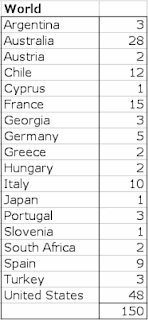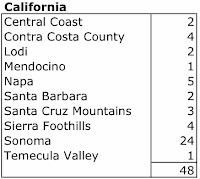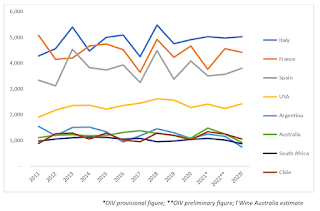God jul! Merry Christmas. Joyeux noël. Fröhe Weihnachten. Feliz Navidad. Buon Natale!
Each country has its own way of marketing wine to its populace. That is, there are commercial, cultural and legal arrangements that facilitate and encourage the transfer of wine from the producers to the customers. These arrangements can differ greatly between countries.
Here, I will look briefly at how the Australians appear to do it, within Australia itself.
The main arrangement is via wine brands, of course. That is, wine is aggregated into volumes that are then marketed under a single name, or label. This is the most common arrangement around the world. The wine producers sometimes create the brands themselves, and thus sell the wine direct to the customers, or they sell the wine to intermediaries, called retailers, who then sell the wine to the consumers.
However, one aspect of the Australian system does seem to differ quite considerably from many other countries. How many of these wine brands are owned by huge conglomerations? That is, there are many wine brands on the retail shelves, but not quite so many companies standing behind those brands.
The web site that contains the most detailed summary of this situation for Australia is: Who makes my wine? It was put online by The Real Review back in February 2018, and was most recently updated in December 2023. This lists which companies dominate wine retailing in Australia, and for which the ownership of their brands is often not publicly disclosed. The Real Review data are summarized below.
There are, of course, wine conglomerates in Australia, who have simply purchased other wine companies. This is widespread throughout the world, as discussed at: The 10 largest wine companies in the world. The biggest of these conglomerates in Australia are shown in this first table. The largest of these, Treasury Wine Estates, is only the fifth largest wine company globally, so there is nothing particularly out of line here.
However, it addition, within Australia there are supermarket conglomerates who are (mostly) inventing wine brands out of thin air. The biggest three collections of these are shown in the second table. Note the massive number of brands (aka “bulk-shipped retailer own-labels”), compared to the first table.
Also, note that the Endeavour Group (formerly called Woolworths supermarkets) actually owns a whole series of acquired “independent” liquor retail outlets, including: Dan Murphy’s, BWS, Langton’s, Cellarmasters, Pinnacle Drinks, Jimmy Brings, and Shorty’s Liquor — these retailers may look different on the outside, but they are all pretty much the same in terms of content,
So, four times as many brands are marketed in Australia by large supermarkets than are marketed by large wine companies. Indeed, back in 2016, Tyson Stelzer (Who makes my wine?) noted that:
The growth in supermarket “Buyer’s Own Brand” wines in Australia has been substantial, estimated to have mushroomed from five percent a decade ago to between 16 and 25 percent of the market today.Do any other countries market wine in this manner? We are told that US-style marketing is being adopted elsewhere (French winemakers adopt US-style marketing to halt falling sales), and this consists of: “In Anglo-Saxon countries, they ask what the consumer wants first.” However, trying to market the Australian supermarket wines elsewhere is not a viable proposition (Australian wine is in crisis — here’s why).
Mind you, the increase in size of the Australian wine conglomerations is likely to continue for the foreseeable future, as it also will for the other world mega-companies (Consolidation moves):
Consolidation is nothing new for the wine industry, but the pace of change has accelerated in recent years as interest rates have risen, costs of labor and supplies have jumped, and demand for wine has softened.Treasury Wine Estates, for example, is buying a substantial vineyard area in New Zealand (Treasury’s New Zealand vineyard expansion); and it has recently made United States acquisitions (The 10 most important M&A deals in drinks in 2023) — these are intended to “strengthen its global portfolio”.
Note:
The Real Review site listed above is a large update of the original Who makes my wine? site (pictured here). It first appeared in the Wayback Machine on November 28, 2010. It listed “100 or so” wines for Coles and Woolworths supermarkets. It was archived last on October 4, 2015, but was gone from the web by January 10, 2016. The domain was later resurrected, and it was first archived by the Wayback Machine on February 26, 2021. I last accessed it in December 2023, when 81 brands were listed. For each wine, it has a pretty good description of the Australian Wine Regions.


































